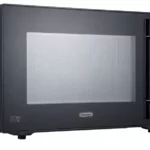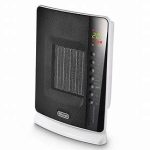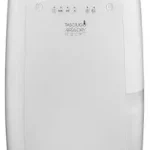
DeLonghi PAC AN HPE Series Portable Air Conditioner
IMPORTANT SAFEGUARDS
- Use this appliance only as described in this instruction manual. As with any electrical appliance, the instructions aim to cover as many situations as possible. Caution and common sense should be used when operating and installing this air conditioner.
- This appliance has been manufactured to cool and dehumidify domestic environments and must not be used for other purposes.
- It is dangerous to alter or modify the unit’s characteristics in any way.
- The appliance must be installed in accordance with the relevant national legislation.
- Should repairs be necessary, contact the nearest authorized Repair Service Center. Unauthorized servicingcanbedangerous.
- The appliance is not intended for use by persons (including children) with reduced physical, sensory or mental capabilities, or lack of experience and knowledge, unless they have been given supervision or instruction concerning use of the appliance by a person responsible for their safety. Children should be supervised to ensure that they do not play with the appliance.
- If the power cable is damaged, it must be replaced by the manufacturer or an authorized technical service centre in order to avoid all risk.
- Always ensure the appliance is plugged into a grounded 3-prong outlet. If you have any doubts check with a qualified electrician.
- Do not use extension cables.
- Before cleaning or maintenance operations, always unplug the unit from the outlet.
- Do not pull on or place strain on the power cord when moving the appliance.
- The appliance should not be installed where the atmosphere may contain combustible gases, oil or sulphur, or near heat sources.
- Do not rest hot orheavy objects on the appliance.
- Clean the filters at least once a week.
- Avoid using heaters near the unit.
- The unit should be transported in a vertical po- sition. If this is not possible secure the unit at an angle, do not lie it horizontally.
- Before transporting the unit, drain the unit. Af- ter transportation, wait at least 6 hours before switching the unit on.
- The packaging materials can be recycled. You are therefore recommended to place them in the special containers for differentiated waste collection.
- This appliance is fitted with a special safety device. When the compressor switches off, this device prevents it from switching on again for at least 3 minutes.
- WARNING: Changes or modifications not ex- pressly approved by the party responsible for compliance could void the user’s authority to operate the equipment.
Specific warnings for appliances with R410A refrigerant gas
R410A is a refrigerant that complies with European ecological standards; nevertheless, it is recommend- ed not to pierce the cooling circuit of the machine. At the end of its useful life, deliver the appliance to a special waste collection centre for disposal. This hermetically sealed system contains fluorinated greenhouse gases.
ENVIRONMENTAL INFORMATION:
This unit contains fluorinated greenhouse gases cov- ered by the Kyoto Protocol. Maintenance and disposal must be carried out by qualified personnel only (R410A, GWP=2088).
Save these instructions
This product is for household only
INTRODUCTION
Thank you for choosing a De’Longhi product. Please take a few moments to read the instructions to avoid risks or damage to the appliance.
DESCRIPTION
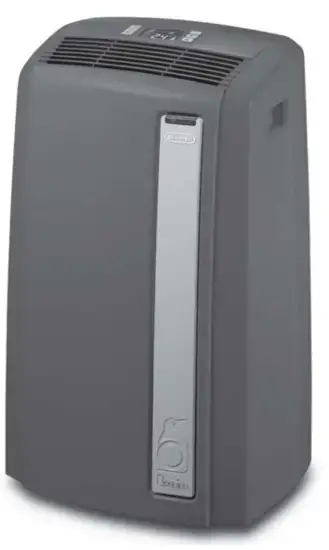
Description of the appliance (see page 3 – A)
A1 Air outlet grille
A2 Control panel
A3 Handles
A4 Castors
A5 Filter
A6 Evaporator air intake grille
A7 Air exhaust hose housing
A8 Condenser air intake grille
A9 Power cable
A10 Drainage with 2 caps
A11 Remote control compartment
A12 Remote control
Description of the control panel (see page 3 – B)
B1 ON /OFF button
B2 MODEselection button
Air conditioning, dehumidifying, heating, fan
B3 Reduce temperature/programme mode time button
B4 Timer button
B5 Fan speed button (MAX/MED/MIN)
B6 Increase temperature/programme mode time button
B7 Air conditioning symbol
B8 Dehumidifying symbol
B9 Heating symbol
B10 Fan symbol
B11 Alarm symbol
B12 Fan speed indicator
B13 Temperature scale indicator
B14 Time indicator
B15 Set temperatures, room temperature and programmed on/off time
B16 Timer symbol
B17 Room temperature symbol
B18 Set temperature symbol
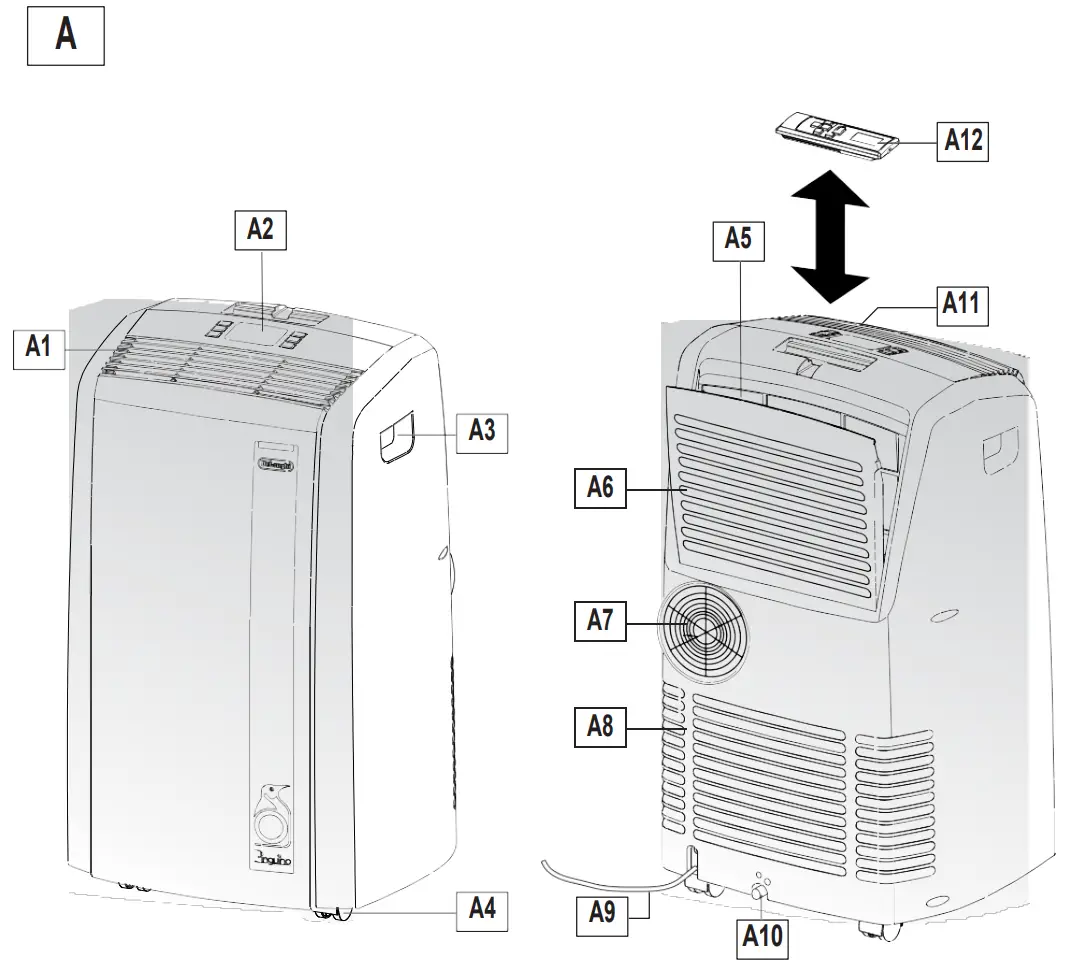
Description of the accessories (see page 2 – C)
C2 Air exhaust hose
C3 Hose adaptor
C4 Accessory for wall mounting
C5 Window bracket with pins
C6 Additional window bracket
C7 Window outlet
C8 Remote control
C9 End of season dust cover
C10 End of season accessories bag
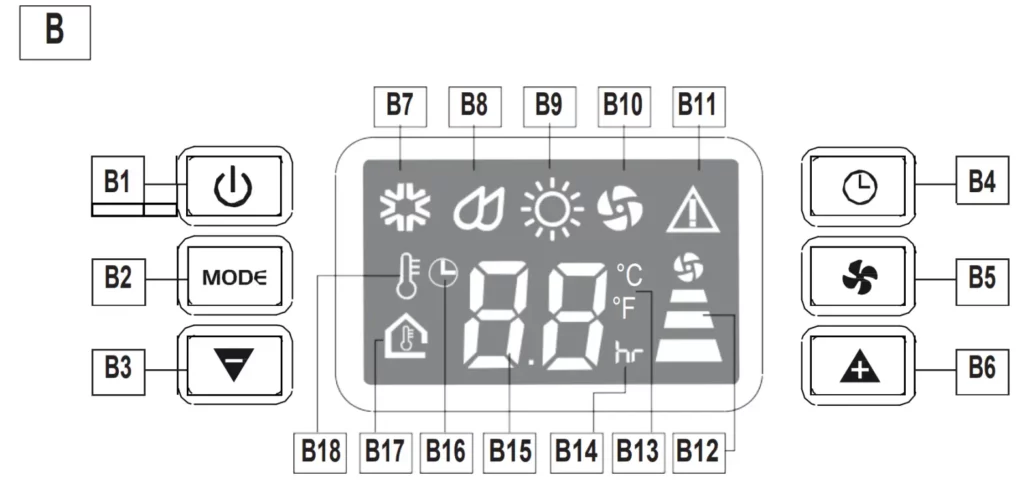
Electrical connection
Before plugging the appliance into the electrical receptacle,
check that:
- The outlet’s power supply corresponds to the value indicated on the rating label on the back of the appliance;
- The outlet and electrical circuit are adequate for the appliance;
- The outlet is a 3-hole grounded outlet
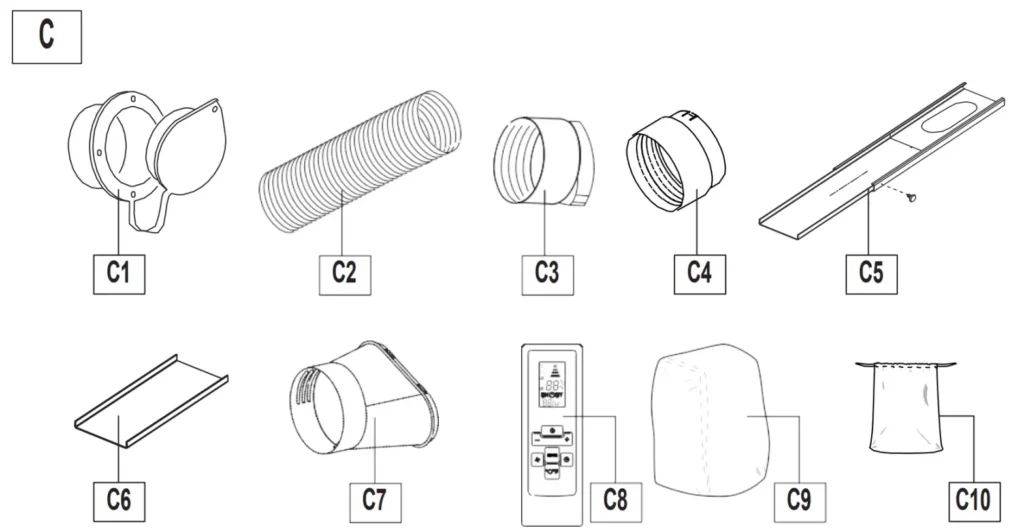 . If this is not the case, you must choose another outlet. Failure to follow these important safety instructions absolves the manufacturer of all liability.
. If this is not the case, you must choose another outlet. Failure to follow these important safety instructions absolves the manufacturer of all liability.
If it becomes necessary, the power cable must be replaced by a qualified professional only.
Theinstructionsbelow willenable you to prepare yourair conditioner for operation as efficiently as possible. Before use, make sure the air intake and outlet grilles are unobstructed.
USE
| Note: This appliance is provided with an auto-evaporation feature for condensate removal during cooling and dehumidifing modes. |
Air conditioning with installation
For optimal results set-up your appliance in this way:
- Screw the hose adaptor C3 to the hose’s end C2.
- Fit the air exhaust hose in the housing at the back of the appliance. Insert it as shown in figure 1.

- Drill a hole (ø134mm / 5.27 in.) in an outside wall or through a window pane.
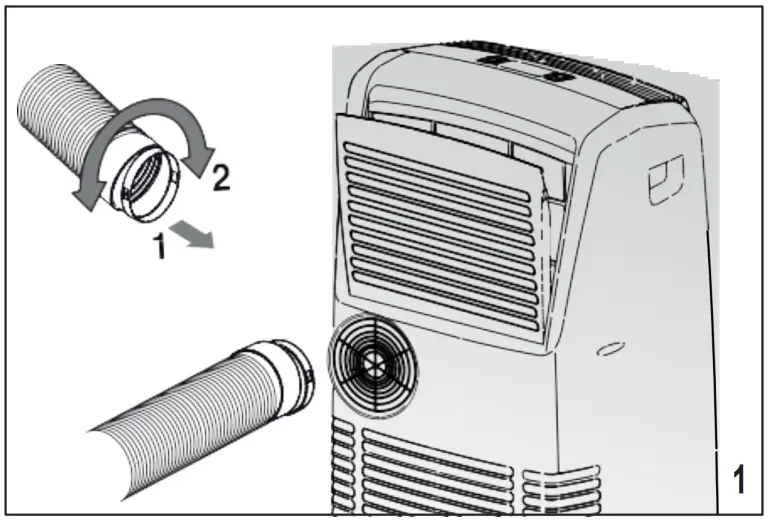
Respect the height and dimensions of the hole given in figures 2 and 3.
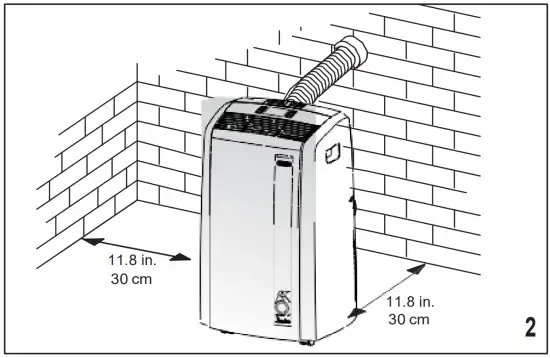
- Fit the wall flange C1 into the hole. 1
- Screw the wall mounting accessory C4 into the hose C2 (fig. 4) and fit it into the wall flange C1 as shown in fig. 5.
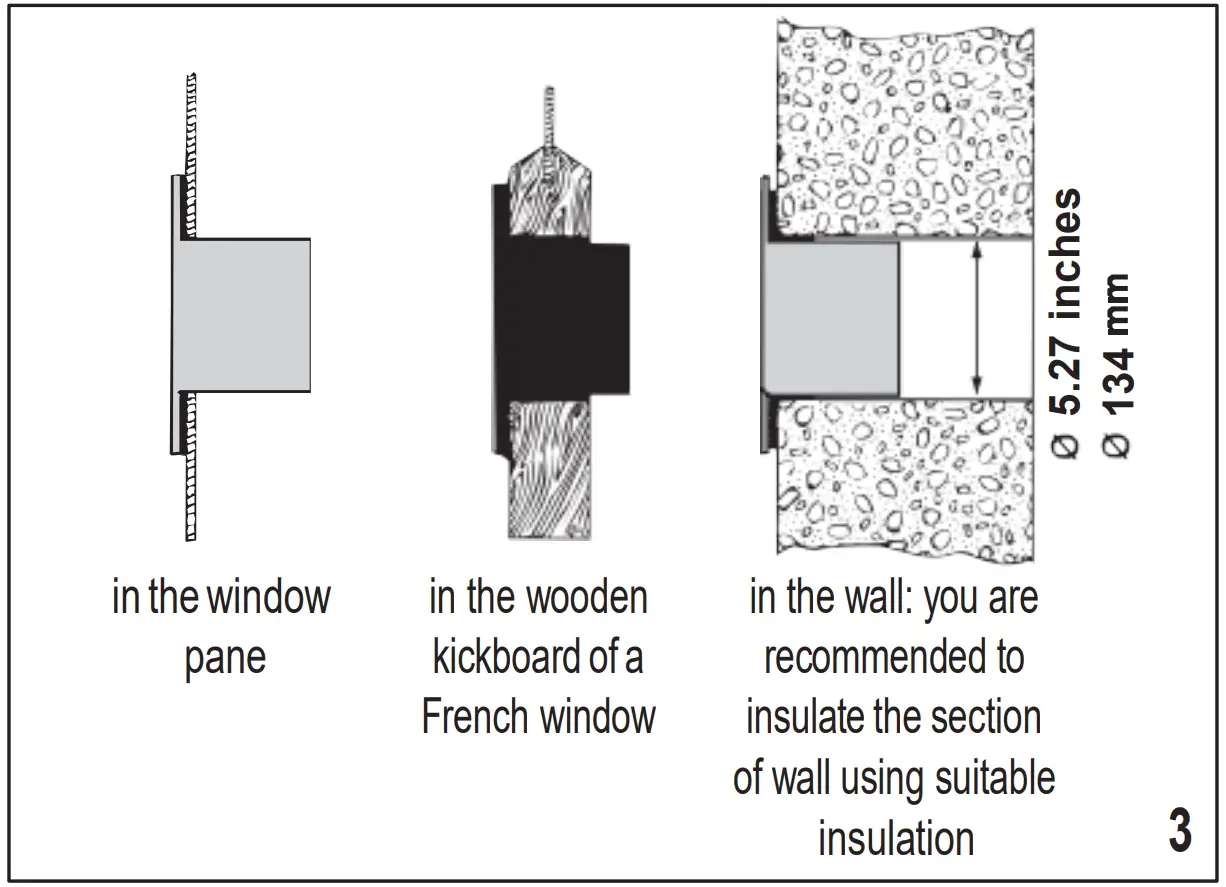
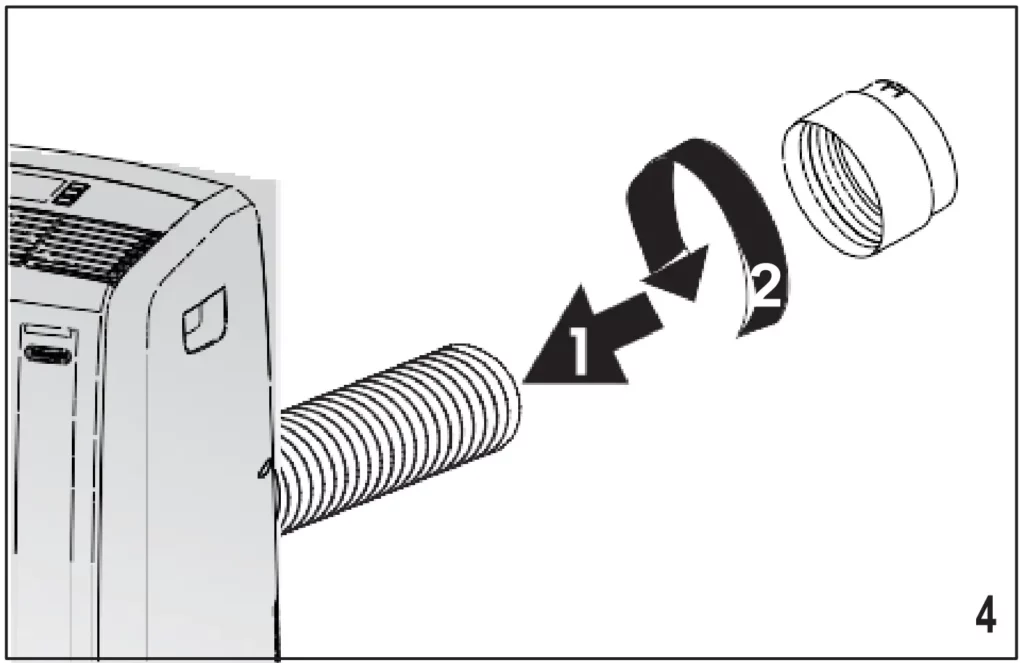
Note:
|
When the hose C2 is not fitted, the hole can be closed with the flange cap C1.
Air conditioning without installation
You can also set-up in a double-hung window:
- Place the bracket in the window sill, extend the bracket fully within the window frame, fix the bracket by using the pin then lower the window onto the bracket. (Should the window bracket be too large for the window, the plastic can be cut with a saw by a qualified professional).
- Fit the air exhaust hose in the housing at the back of the appliance. Insert it as shown in fig. 1.
- Screw the window outlet C7 to the other end of the exhaust hose (see fig. 6).
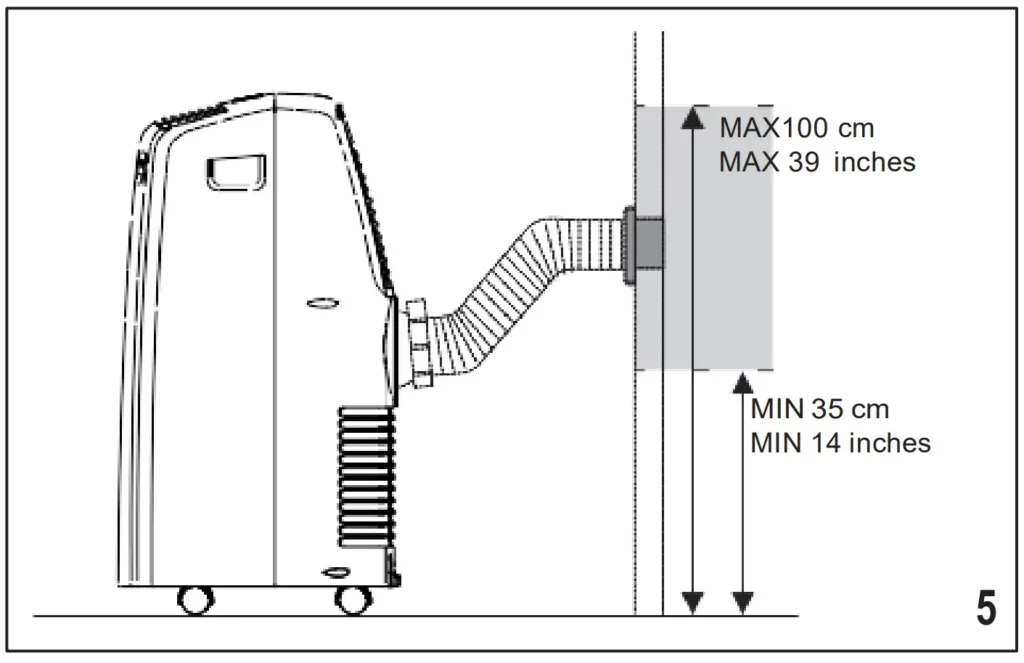
- Insert the window outlet end of the exhaust hose into the slot of the window bracket (fig. 7).
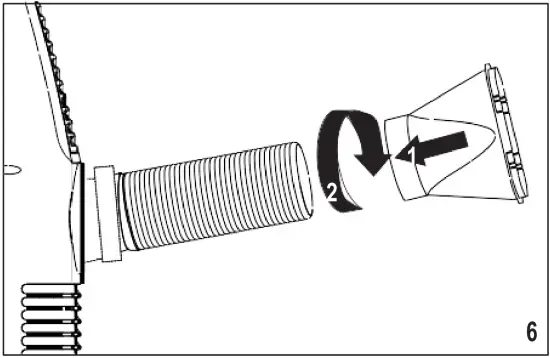
Other set-up methods:
- Thanks to the locking pins, it’s possible to use the win- dow bracket also for sliding windows. Position the hole 7 of the bracket so to allow a correct installation of the exhaust hose (see fig. 8).
- If you have a casement window follow steps 2 & 3 and place the window outlet outside the window to exhaust the hot air (fig. 9).
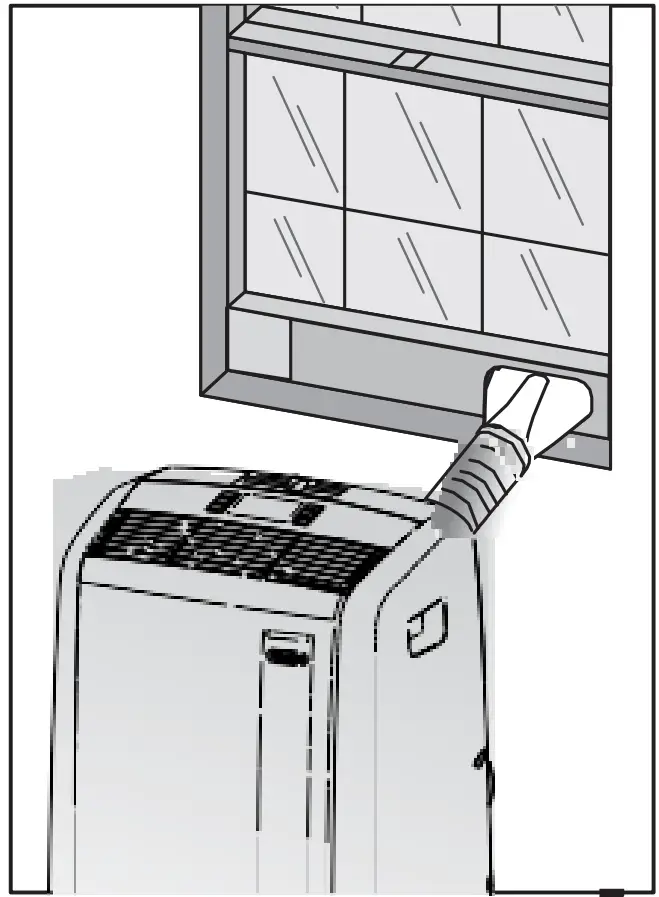
| For help with installation, operation, and fo rall button (B6) or but accessories and spare/replacement parts, please contact our toll free customer service call center at: 1-800-322-3848 [USonly] 1-888-335-6644 [Canada only] 01-800-711-8805 (Mexico only] or log onto our website at www.delonghi.com |
OPERATING FROM THE CONTROL PANEL
Note:
- Before plugging theappliancecheckthe capsonthe back of the unit are correctly inserted and screwed on thedrainagehose A10.
- Never turn the air conditioner off by unplugging from the outlet. Always press the button,
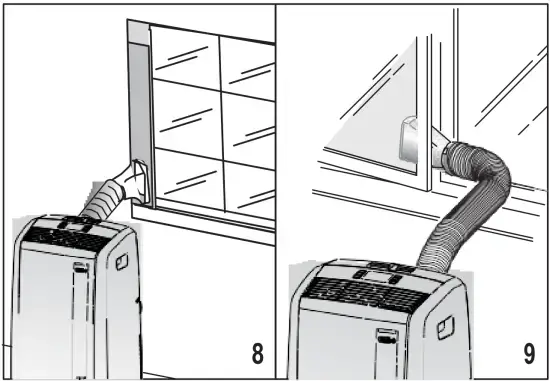 then wait for a few minutes before unplugging. This allows the appliance to perform a cycle of checks to verify operation
then wait for a few minutes before unplugging. This allows the appliance to perform a cycle of checks to verify operation
TURNING THE APPLIANCE ON
Plug into the electrical receptacle. Two lines appear on the display indicating that the appliance is in stand-by (fig. 10).
Press the  button (B1).
button (B1).
The first time the appliance

The first time the appliance is turned on, it will be in air conditioning mode. Room temperature will be displayed and fan speed will be at minimum (fig. 11). When turned on subsequently it will be in the same mode as when last turned off.
Press the MODE button (B2) until the light corresponding to the desired mode lights up:
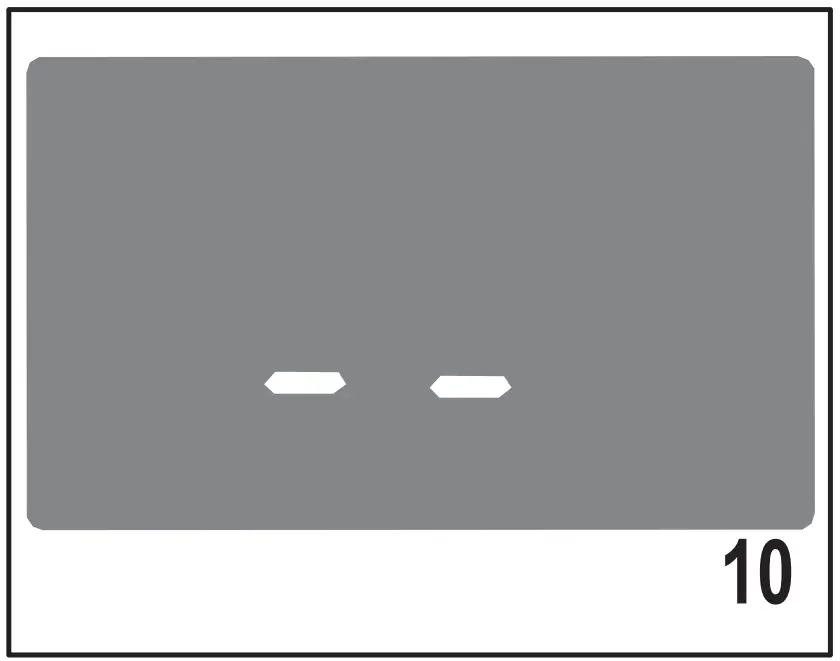
 Air conditioning symbol (B7)
Air conditioning symbol (B7)
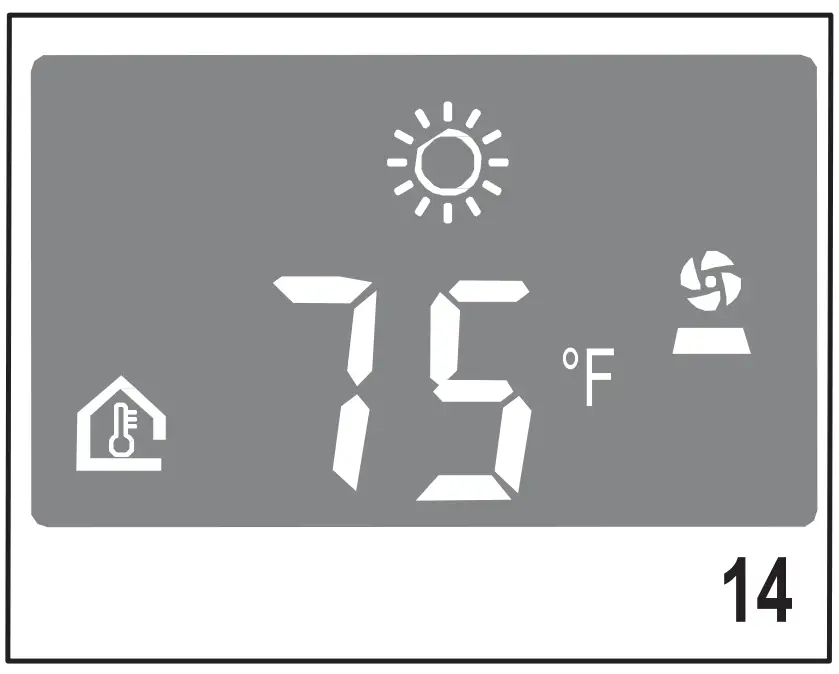 Dehumidifying symbol (B8)
Dehumidifying symbol (B8)
 Heatingsymbol(B9)
Heatingsymbol(B9)
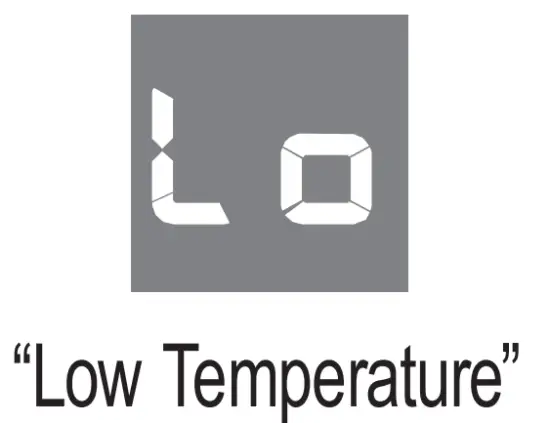 Fan symbol (B10)
Fan symbol (B10)

Ideal for hot muggy weather when you need to cool and dehumidify the room.
To set this function correctly:
- Press the MODE button a number of times until the air conditioning symbol appears. Room temperature is displayed (fig. 11)
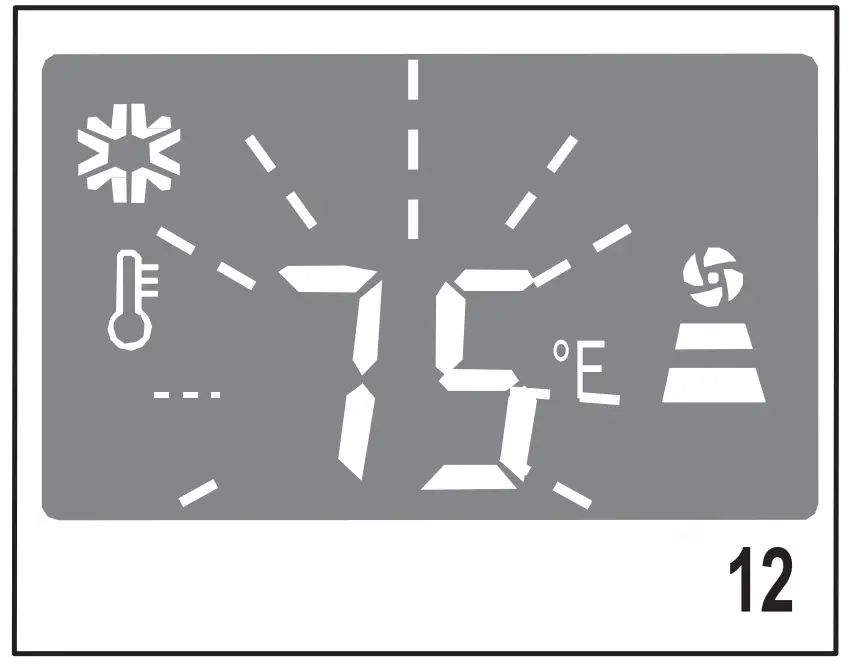
- Select the target temperature by pressing the button (B6) or button (B3) until the required value is displayed. During selection, the temperature flashes (fig. 12).
After 10 seconds, room temperature is displayed again. - Select the required fan speed by pressing the button.
There are 3 speeds available:
 High speed: to achieve the target temperature as rapidly as possible;
High speed: to achieve the target temperature as rapidly as possible;
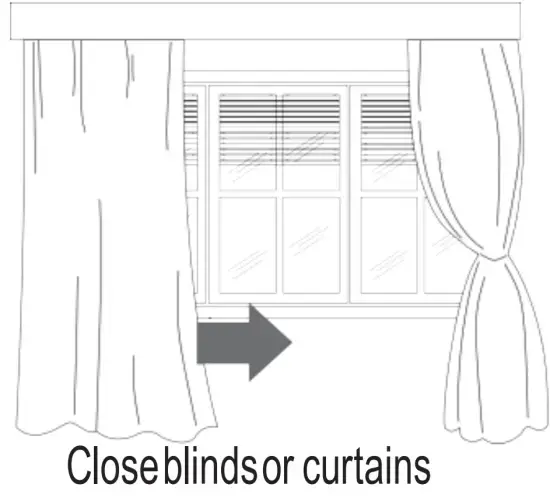 Medium speed: reduces noise levels but still maintains a good level of comfort;
Medium speed: reduces noise levels but still maintains a good level of comfort;
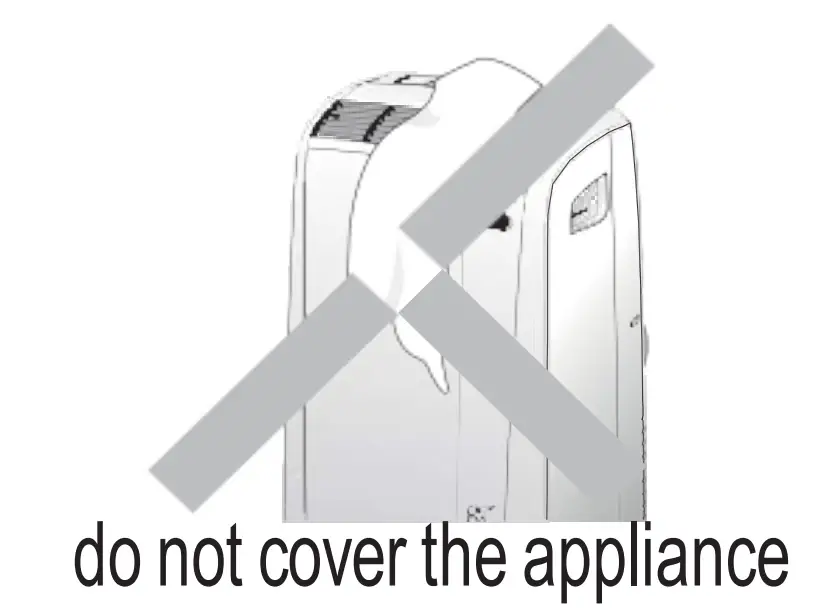 Low speed: for silent operation.
Low speed: for silent operation.
The most suitable indoor temperature for the room during the summer varies from 75°F to 81°F (24 to 27°C). You are recommended, however, not to set a temperature much below the outdoor temperature.
Note:
When installing the air conditioner, you should leave a door slightly open little as 1/2“ (1 cm) to guarantee correct ventilation and room pressure.

Ideal to reduce room humidity (spring and autumn, damp rooms, rainy periods, etc). For this mode, the appliance should be prepared in the same way as for air conditioning, with the air exhaust hose attached to enable the moisture to be discharged outside.
To set this function correctly:
- Press the MODE button a number of times until the dehumidifying symbol appears (fig. 13).
In this mode, with room temperature above 77 °F, the fan speed isadjustable. If the temperature isbelow, fanspeedis selected automatically by the appliance and cannot be set manually

This is ideal in spring and autumn when outdoor temperatures are not particularly severe.
For this mode, the appliance should be prepared in the same way as for air conditioning, with the air exhaust hose attached to enable the moisture to be discharged outside.
For this mode, the appliance should be prepared in the same way as for air conditioning, with the air exhaust hose attached to enable the moisture to be discharged outside.
To set this function correctly:
- Press the MODE button a number of times until the °F heating symbol
 appears (fig. 14).
appears (fig. 14).

- Select the required fan speed by pressing the
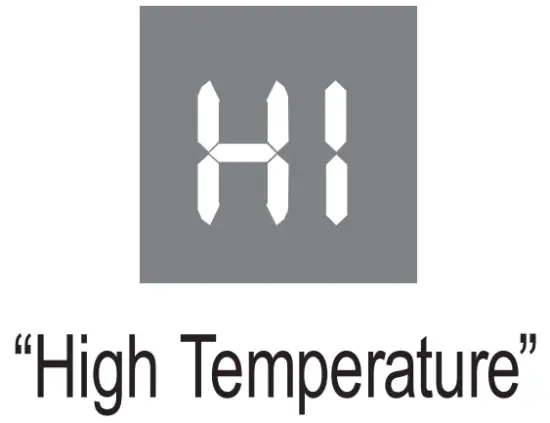 button (B5).
button (B5).
 High speed: to achieve the target temperature as rapidly as possible
High speed: to achieve the target temperature as rapidly as possible
 Medium speed: reduces noise levels but still maintains a good level of comfort
Medium speed: reduces noise levels but still maintains a good level of comfort
 Low speed: for silent operation
Low speed: for silent operation
With particular room conditions (e.g. low temperature or high temperature), the appliance will automatically select the operating fan speed however, If the unit is cold, it will automatically perform a pre-heating cycle. It can take several minutes and fan will not operate until pre-heating cycle is over. In this mode, the fan may operate for short periods, even though the set temperature has already been reached

When using the appliance in this mode, the air exhaust hose does not need to be attached.
To set this function correctly:
- Press the MODE button (B2) a number of times until the fan symbol
 appears.
appears. - Select the required fan speed by pressing the
 button (B5).
button (B5).
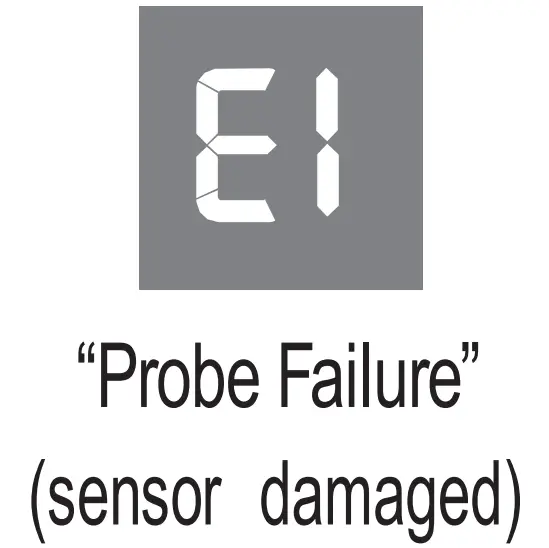
 High speed: for maximum fan power (fig. 15);
High speed: for maximum fan power (fig. 15);
 Medium speed: reduces noise levels but still maintains a good level of comfort (fig. 16);
Medium speed: reduces noise levels but still maintains a good level of comfort (fig. 16);
 Low speed: for silent operation (fig. 17).
Low speed: for silent operation (fig. 17).
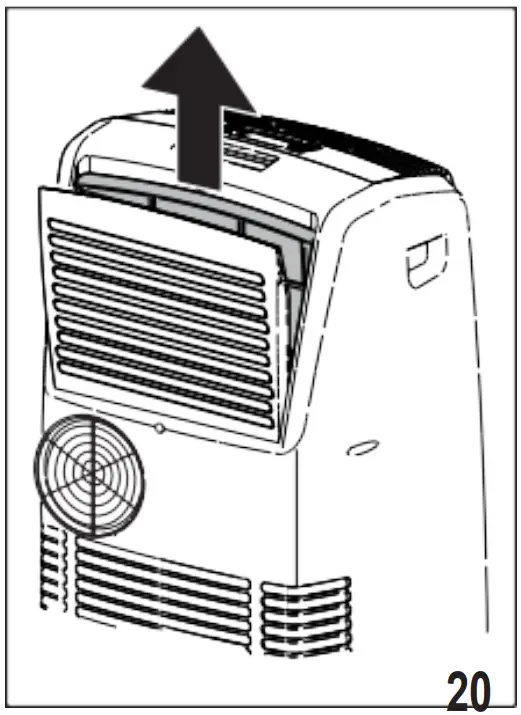
To change the unit of measurement forthedisplayed temperature, press the 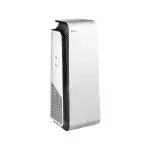 and
and 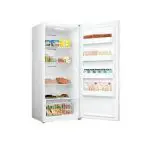 buttons together for 3 seconds.
buttons together for 3 seconds.
SETTING THE TIMER
The timer can be used to delay when the appliance comes on or goes off. This avoids wasting electricity by optimising operating periods.
How to programme delayed start up
- Plug the appliance into an electrical receptacle. It will be in STAND-BY.
- Press the timer button (B4).
The timer symbol (B16) comes on (fig. 18). - Use the
 (B6) or
(B6) or  (B3) buttons to set the number ofhoursdelay before the appliance comeson. They increase or decrease the time in steps of an hour.
(B3) buttons to set the number ofhoursdelay before the appliance comeson. They increase or decrease the time in steps of an hour.
The appliance can be set to come on within the next 24 hours.
Five seconds after the timer has been set, the display dims and the setting is memorised.
Aftersetting, the operating mode and fan speed can be modified.
To cancel the timer programme, press the timer button (B4) again. Pressing the ON/OFF button (B1) cancels the timer programme and the air conditioner comes on immediately in the selected mode.
How to programmedelay OFF
Delay OFF can be programmed in any operating mode – air conditioning/fan/ dehumidifying.
- Press the timer button (B4).
The timer on symbol (B16) comes on (fig. 19).
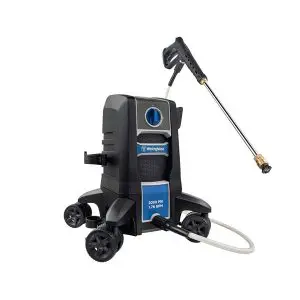
- Use the
 (B6) or
(B6) or  (B3) buttons to set the number of hours delay before the appliance goes off.
(B3) buttons to set the number of hours delay before the appliance goes off.
They increase or decrease the time in steps of an hour.
The appliance can be set to go off within the next 24 hours.
Five seconds after the timer has been set, the operating mode is displayed and the timer symbol remains on.
At the set time, the air conditioner goes off and remains in stand-by.
To cancel the timer programme, press the timer button (B4) again. The timer symbol goes off.
After setting, the operating mode and fan speed can be modified
OPERATING FROM THE REMOTE CONTROL
Usingthe remote control
- Point the remote control at the receiver on the air conditioner. The remote control must be no more than 16,4ft (5 meters) away from the appliance (without obstacles between the remote control and the receiver).

Description of the remote control (D)
D1) “ON/OFF”button
D2) Increase/Decrease button for temperature/programmed use
D3) “MODE” button
D4) “TIMER” button
D5) °F/°Cscalebutton
D6) Fan speed selection button (MAX/MED/MIN)

Inserting or replacing the batteries
- Remove the cover on the rear of the remote control;
- Remove the old batteries, if present.
- Correctly insert two new L03 “AAA” 1,5V batteries (see the instructions inside the battery compartment);
- Replace the cover.
If the remote control unit is replaced or discarded, the batteries must be removed and disposed of in accordance with current legislation as they are harmful to the environment. Do not mix old and new batteries. Do not mix alkaline, standard (carbon-zinc) or rechargeable (nickel-cadmium) batteries. Do not dispose of batteries in fire. Batteries may explode or leak. If the remote control will not be used for a certain length of time, remove the batteries.
- Note: This equipment has been tested and found to comply with the limits for a Class B digital device, pursuant to part 15 of the FCC Rules. These limits are designed to provide reasonable protection against harmful interference in a residential installation.
- This equipment generates, uses and can radiate radio frequency energy and, if not installed and used in accordance with the instructions, may cause harmful interference to radio communications. However, there is no guarantee that interference will not occur in a particular installation. If this equipment does cause harmful interference to radio or television reception, which can be determined by turning the equipment off and on, the user is encouraged to try to correct the interference by one or more of the following measures.
– Reorient or relocate the receiving antenna.
– Increase the separation between the equipment and receiver.
– Connect the equipment into an outlet on a circuit different from that to which the receiver is connected.
– Consult the dealer or an experienced radio/TV technician for help. Changes or modifications not expressly approved by the party responsible for compliance could void the user’s authority to operate the equipment. - This device complies with Part 15 of the FCC Rules. Operation is subject to the following two conditions: (1) this device may not cause harmful interference, and (2) this device must accept any interference received, including interference that may cause undesired operation.
- This Class B digitalapparatus complieswith Canadian CAN ICES-3 (B) / NMB-3 (B)
Turning the appliance ON
Plug the appliance into the the electrical receptacle.
Press the ON/OFF button (B1) (when turned on, the air conditioner starts operating in the same mode as when it was turned off).
Press the MODE button (B2) to select the required mode
COOLING
DEHUMIDIFYING
HEATING
FAN ONLY
On the control panel, the light corresponding to the selected mode comeson.
For air conditioning/dehumidifying/heating/fan only settings and programming the timer, see the relative paragraph.
SELF-DIAGNOSIS
Theappliance has a self diagnosis system to identify a numberof malfunctions. Error messages are displayedon theappliance display.
| IF…IS DISPLAYED, | IF…IS DISPLAYED, | IF…IS DISPLAYED, |
 …MEANS: room temperature is too low …MEANS: room temperature is too low |
 …MEANS: room temperature is too high …MEANS: room temperature is too high |
 …MEANS: contact your local customer service …MEANS: contact your local customer service |
TIPS FOR CORRECT USE
To get the best from your air conditioner, follow these recommendations:
- Close the windows and doors in the room to be air conditioned. When installing the air conditioner semipermanently, you should leave a door slightly open (as little as 1/2 inch (1 cm) to guarantee proper ventilation.

- Never use the appliance in very damp rooms (laundries for example).
- Protect the room from direct exposure to the sun by partially closing curtains and/or blinds to make the appliance much more economical to run.

- Never use the appliance outdoors.
- Make sure there are no heat sources in the room.
- Make sure the air conditioner is standing on a level surface.

- Never rest objects of any kind on the air conditioner.
- Never obstruct the air intake or outlet grilles.
CLEANING
Before cleaning or maintenance, turn the appliance off by pressing the ON/OFF button (B1) or in models with remote control unit, by pressing the ON/OFF button (D1), then always unplug the appliance from the electrical receptacle.
Cleaningthe cabinet
You should clean the appliance with a slightly damp cloth then dry with a dry cloth.
For safety reasons, never wash the air conditioner with water.
Precautions
Never use petrol, alcohol or solvents to clean the appliance.
Never spray insecticide liquids or similar.
Cleaning the silver ion air filter
If the filter is dirty, air circulation is compromised and the efficiency of the dehumidifying and air purifying functions decreases.
It is therefore good practice to clean the filter at regular intervals. The frequency depends on the duration and conditions of operation.
If the unit is used constantly or systematically, you are recommended to clean the filter once a week.
The filter is housed in the intake grille.
To clean the filter, extract as shown in fig. 20.
Use a vacuum cleaner to remove the dust collected on the filter. If it is very dirty, immerse in warm water and rinse a number of times. The water should never be hotter than 104°F ( 40°C).
After washing, leave the filter to dry. Put the filter back in its housing.
The silver ion filter not just retains dust particles, but also has an efficient antibacterial action. It also greatly reduces concentrations of irritants such as pollenand spores.

Start of season checks
Make sure the power cable and plug are undamaged and the ground connection is efficient. Follow the installation instructions precisely.
End of season operations
To drain all water from the circuit, remove the external cap by unscrewing it in the anticlockwise direction then, remove the internal cap from the drain hose on the back of the appliance and allow the water to drain out into a basin (fig. 21).
When the appliance is empty, replace thecaps.
Clean the filter and dry thoroughly before putting back. In order to properly storage the appliance at the end of the season, we suggest you cover it with the supplied end of season dust cover C9 and you put the accessories in the relevant end of season accessories bag C10.

TECHNICAL SPECIFICATION
Power supply voltage see rating label
Max. absorbed power during air conditioning “
Max. power input during heating “
Refrigerant “
Cooling capacity “
LIMIT CONDITIONS
Room temperature for air conditioning (with fan at maximum speed) 64 ÷ 104°F – 18 ÷ 40°C
Room temperature for heating 50 ÷ 77°F – 10 ÷ 25°C
Transport, filling, cleaning, recovery and disposal of refrigerant should be performed by a technical service centre appointed by the manufacturer only.
Theapplianceshouldbedisposedof by a specialistcentre appointed by the manufacturer only.
TO AVOID DAMAGE TO THE UNIT
NEVER TRANSPORT OR TURN THE APPLIANCE UPSIDE DOWN OR ON ITS SIDE. IF THIS OCCURS, WAIT 6 HOURS BEFORE TURNING THE APPLIANCE ON, 24 HOURS IS RECOMMENDED. After the unit has been on its side, oil needs to return to the compressor to ensure proper function. Without allowing the unit this time (6-24 hours) the unit may function for only a short time, and then thecompressor will break down from lack of oil.
CHARACTERISTICS OF THE PLUG
This appliance is equipped with a 3 prong grounded plug. The plug must be connected into an outlet that is properly installed and grounded in the accordance with all local codes and ordinances. Do not modify the plug provided with the appliance.
If it will not fit the outlet, have a proper outlet installed by a qualified electrician or relocate the unit to a proper outlet. If the household electrical supply does not meet the above specifications, or if you are not sure your home has an effective electrical ground, have a qualified electrician or your local electrical utility company check it and correct any problems.
SAFETY PLUG
The appliance is fitted with a safety plug to protect the power cable.
If power is cut off, unplug from the outlet and make sure the power cable is undamaged.
If the cable is damaged, call the service center immediately.
If power cuts off frequently and the power cable is undamaged, contact a qualified electrician
OPERATION OF THE SAFETY PLUG
If the safety device incorporated in the plug trips and cuts off the power supply, check that the power cable and plug are not damaged.
If the power cable is undamaged, to restore operation press the “RESET” button.
To verify correct operation of the plug, press the “TEST” button periodically and make sure the appliance disconnects. If this is not the case, contact the service center.
To restore operation, press the “RESET”button.
TROUBLESHOOTING
| PROBLEM | CAUSE | REMEDY |
| The air conditioning unit does not start. | No electricity. | Wait. |
| It is not plugged into the electrical receptacle. | Plug into the electrical receptacle. | |
| The safety device of the plug has tripped. | Reset the safety device, if problem persists contact our toll free customer service. | |
| The air conditioning unit works for a short time only. | The air exhaust hose has a constriction. | Position the exhaust hose correctly. |
| The air exhaust hose is blocked. | Check there are no obstacles that obstruct the air discharge. | |
| There are tight bends in the air exhaust hose. | Eliminate the tight bends. | |
| The air conditioner works, but does not cool the room. | Window open. | Close the window. |
| The exhaust hose is detached. | Connect the exhaust hose. | |
| Air filter clogged. | Clean or replace the filter. | |
| Heating Mode is selected, but fan doesn’t work | Air conditioner needs to warm up | Wait several minutes for Pre-Heating Cycle to complete |
| Unpleasant smell in the room | Airpurifyingfilterclogged | Clean or replace the filters. |
| The air conditioner does not operate for about 3 minutes after turning it on | The safety device has tripped | Wait for three minutes (it is due to a nor- mal safety check) |
| The alarm symbol ⚠ comes on | The tray inside the appliance is full. | Empty the tank (see “End of season operations”). |

